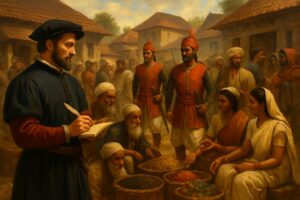Inside the Glittering Capital: Portuguese Merchant Reveals Daily Life in 16th Century Vijayanagara
*By Historical News Network Staff | May 20, 2025*
A Portuguese merchant’s detailed account of life in the magnificent capital of the Vijayanagara Empire offers a rare glimpse into what was once described as “the best-provided city in the world” during its golden age.
Domingo Paes, who visited the empire between 1520-1522 during the reign of the celebrated Emperor Krishnadevaraya, documented his observations in remarkable detail, painting a vivid picture of urban life in what was then one of the world’s greatest cities.
“The city is as large as Rome and very beautiful,” wrote Paes in his chronicle. “It has a circumference of sixty miles, surrounded by mountain ranges on one side and massive stone walls on the others.”
According to Paes, Vijayanagara (modern-day Hampi in Karnataka) was a bustling metropolis with specialized market streets that would rival today’s most sophisticated commercial centers.
“You can find streets dedicated entirely to jewels – diamonds, rubies, emeralds – and others for textiles, spices, or metalwork,” he noted. “The organization is remarkable, with merchants from Arabia, Persia, Bengal, China and beyond conducting trade with perfect order despite the enormous crowds.”
The Portuguese visitor was particularly impressed by the city’s advanced infrastructure, especially its water management systems. Engineers had constructed an elaborate network of aqueducts, canals, and massive water tanks that ensured a reliable supply for the metropolis despite its semi-arid location.
“Their ability to capture, store and distribute water throughout this vast city demonstrates engineering skill that would impress even modern builders,” said Dr. Anjali Sharma, historian at Delhi University. “These systems supported not only drinking water needs but also extensive urban agriculture and decorative gardens.”
Paes’s account reveals fascinating details about Emperor Krishnadevaraya’s daily routine. The monarch would rise early, bathe, and then make himself available to hear petitions from citizens of all social ranks.
“What struck Paes was the emperor’s accessibility,” explained Dr. Sharma. “Despite ruling a vast empire, Krishnadevaraya maintained regular hours where even common people could approach him with their concerns – a practice that contrasted sharply with the more isolated European monarchs of the same period.”
The Portuguese merchant’s most detailed descriptions were reserved for the nine-day Mahanavami festival (also called Dasara), which showcased the empire’s wealth and military might.
“The festival featured elaborate processions with thousands of soldiers, hundreds of elephants adorned with jewels and gold, and public ceremonies where the emperor was weighed against gold that was then distributed to Brahmins,” said Dr. Sharma. “It was both a religious celebration and a political statement of imperial power.”
Paes also documented the social structure of Vijayanagara, noting the distinct roles and customs of different castes, from Brahmins with their vegetarian diets and ritual practices to merchants, craftspeople, and agricultural workers.
Women’s lives in the empire received particular attention in his account. While elite women generally lived in seclusion, Paes noted they wielded considerable influence within households. He also described the devadasis (temple dancers), noting their artistic skills and social position.
“What makes Paes’s account so valuable is that he wrote as an observer rather than a conqueror,” noted Dr. Sharma. “Unlike later colonial writers, he documented what he saw with curiosity rather than judgment, giving us one of our clearest windows into daily life in pre-colonial South India.”
The Vijayanagara Empire would continue to flourish for several decades after Paes’s visit, but in 1565, a coalition of Deccan sultanates defeated the imperial forces at the Battle of Talikota. The magnificent capital was subsequently abandoned and fell into ruins.
Today, the archaeological site at Hampi preserves the remnants of the once-glorious city that so impressed the Portuguese merchant. Historians and archaeologists continue to use Paes’s detailed descriptions to interpret these ruins and reconstruct the vibrant urban center he witnessed at its peak.
“Reading Paes’s account reminds us that South India had sophisticated urban centers with complex economic and social systems long before European colonization,” Dr. Sharma concluded. “His observations help us appreciate the achievements of the Vijayanagara civilization and its place in world history.”

